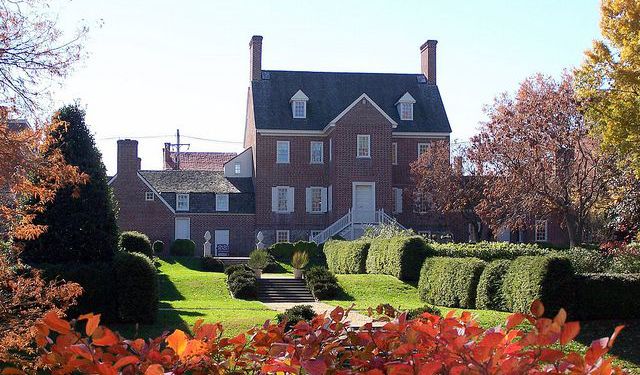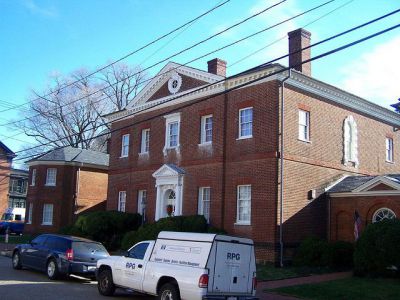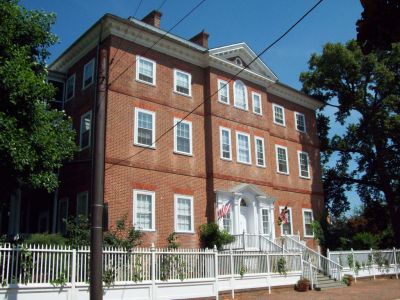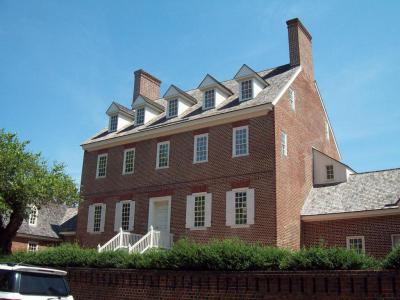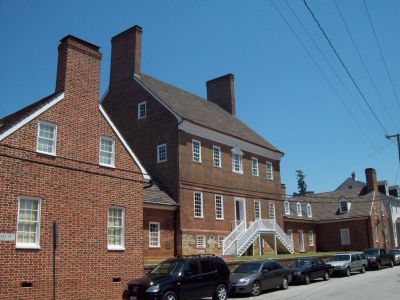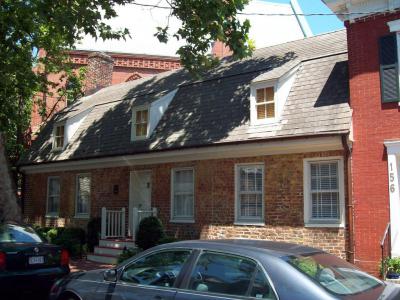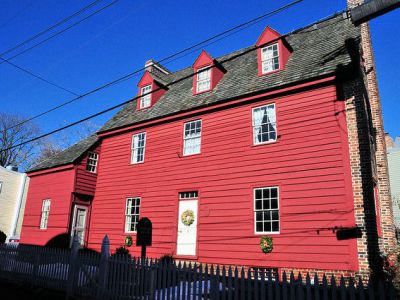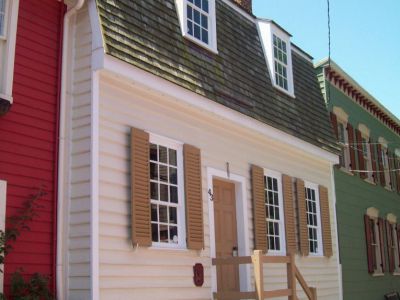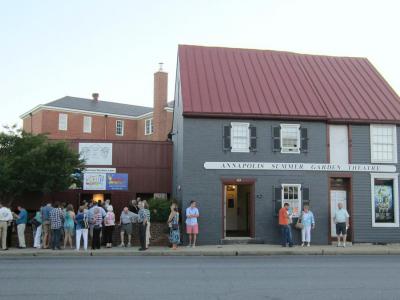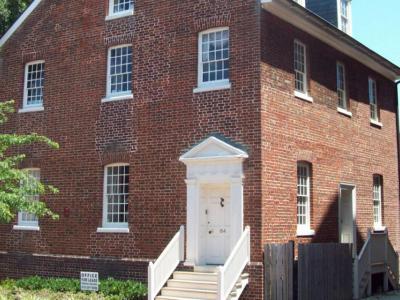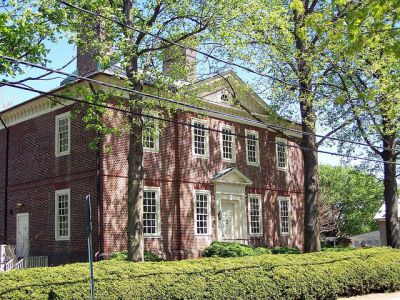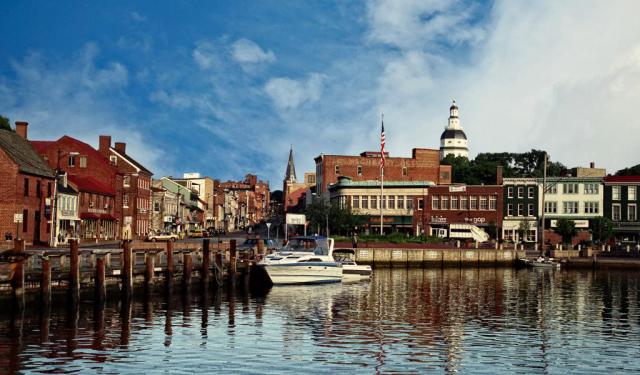Annapolis Historical Houses Tour (Self Guided), Annapolis
One of the first planned cities in colonial America, first the capital of the Colony and then of the State of Maryland, Annapolis is rich in history, predating the Revolutionary War by decades. Although many structures from its early days are either gone, destroyed by neglect, or completely renovated, several magnificent 18th-century homes are still in place and retain their original beauty.
The Hammond-Harwood House, a masterpiece of colonial architecture, stands as a testament to Annapolis's affluent past. The Chase-Lloyd House, with its Georgian-style architecture, reflects the elegance of the 18th century. Meanwhile, the William Paca House and Garden transport visitors to the lavish lifestyle of a prominent signer of the Declaration of Independence.
The Brice House and Garden offer a glimpse into the opulent lifestyle of Annapolis' elite, while the Patrick Creagh House showcases the city's architectural diversity. The Shiplap House, with its quaint appearance, is reputed to be haunted by several spirits, adding an eerie dimension to its historical charm.
Artisan's House epitomizes a typical 18th-century modest, middle-class dwelling in the city, while the Annapolis Summer Garden Theatre brings the performing arts to life in a historic setting. The John Callahan House and Upton Scott House round out the list, each contributing its unique story to Annapolis's vibrant past.
Exploring these historical houses is an exciting journey through time that may be equally interesting to a history enthusiast, architecture buff, or anyone simply curious about the city's yesteryear. So, whenever you're in Annapolis, consider taking this self-guided walk and acquaint yourself with the stories of these fascinating properties. Your adventure awaits!
The Hammond-Harwood House, a masterpiece of colonial architecture, stands as a testament to Annapolis's affluent past. The Chase-Lloyd House, with its Georgian-style architecture, reflects the elegance of the 18th century. Meanwhile, the William Paca House and Garden transport visitors to the lavish lifestyle of a prominent signer of the Declaration of Independence.
The Brice House and Garden offer a glimpse into the opulent lifestyle of Annapolis' elite, while the Patrick Creagh House showcases the city's architectural diversity. The Shiplap House, with its quaint appearance, is reputed to be haunted by several spirits, adding an eerie dimension to its historical charm.
Artisan's House epitomizes a typical 18th-century modest, middle-class dwelling in the city, while the Annapolis Summer Garden Theatre brings the performing arts to life in a historic setting. The John Callahan House and Upton Scott House round out the list, each contributing its unique story to Annapolis's vibrant past.
Exploring these historical houses is an exciting journey through time that may be equally interesting to a history enthusiast, architecture buff, or anyone simply curious about the city's yesteryear. So, whenever you're in Annapolis, consider taking this self-guided walk and acquaint yourself with the stories of these fascinating properties. Your adventure awaits!
How it works: Download the app "GPSmyCity: Walks in 1K+ Cities" from Apple App Store or Google Play Store to your mobile phone or tablet. The app turns your mobile device into a personal tour guide and its built-in GPS navigation functions guide you from one tour stop to next. The app works offline, so no data plan is needed when traveling abroad.
Annapolis Historical Houses Tour Map
Guide Name: Annapolis Historical Houses Tour
Guide Location: USA » Annapolis (See other walking tours in Annapolis)
Guide Type: Self-guided Walking Tour (Sightseeing)
# of Attractions: 10
Tour Duration: 1 Hour(s)
Travel Distance: 1.6 Km or 1 Miles
Author: AudreyB
Sight(s) Featured in This Guide:
Guide Location: USA » Annapolis (See other walking tours in Annapolis)
Guide Type: Self-guided Walking Tour (Sightseeing)
# of Attractions: 10
Tour Duration: 1 Hour(s)
Travel Distance: 1.6 Km or 1 Miles
Author: AudreyB
Sight(s) Featured in This Guide:
- Hammond-Harwood House
- Chase-Lloyd House
- William Paca House and Garden
- Brice House and Garden
- Patrick Creagh House
- Shiplap House
- Artisan's House
- Annapolis Summer Garden Theatre
- John Callahan House
- Upton Scott House
1) Hammond-Harwood House
The Hammond-Harwood House is one of the premier and, arguably, the most exquisite property remaining in the United States from the British Colonial period (1607–1776). The house was designed by architect William Buckland in 1773-74. It ranks architecturally with many of the great mansions built in the late Colonial period, and is the only existing work of the Colonial academic architecture that was principally designed from a plate in Andrea Palladio’s I Quattro Libri dell’Architettura.
The Hammond-Harwood House is a five-part brick edifice with a five-bay two-story central block, two-story end wings and one-story connecting hyphens on either side. The central block has a shallow hipped roof. The wings project toward the street with three-sided hipped-roof bays. The hyphens are rendered as a blind arcade, with the central bay a door opening with a pediment above. There is little decoration, with plain rubbed brick flat arches over the windows. The interior presents the appearance of symmetry where it is in fact not symmetrical, using false doors where necessary to maintain the illusion.
The Hammond-Harwood House is a five-part brick edifice with a five-bay two-story central block, two-story end wings and one-story connecting hyphens on either side. The central block has a shallow hipped roof. The wings project toward the street with three-sided hipped-roof bays. The hyphens are rendered as a blind arcade, with the central bay a door opening with a pediment above. There is little decoration, with plain rubbed brick flat arches over the windows. The interior presents the appearance of symmetry where it is in fact not symmetrical, using false doors where necessary to maintain the illusion.
Sight description based on Wikipedia.
2) Chase-Lloyd House
The Chase-Lloyd House in Annapolis is a three-story brick Georgian mansion, dating from 1769-1774, with interiors by William Buckland.
Its construction was started for Samuel Chase, who would later be a signatory to the Declaration of Independence and Associate Justice of the Supreme Court, but Chase sold the building unfinished to Edward Lloyd IV in 1771. Lloyd completed the house in 1774 with assistance from Buckland and another architect, William Noke. The house remained in the Lloyd family until 1847, when it was sold back to the descendants of Chase.
The house's plan is of the four room, center hall type, but on a very large scale. The entrance hall contains a screen of free-standing Ionic order columns, beyond which a central stair rises to the large Palladian window at the landing. The ascending stair flights split at the landing, rising in parallel runs to flank the first run on either side. In 1888 the house was bequeathed for use as a home for elderly women, and it continues in this use today. While the upper floors are off limits to visitors, the main floor and the extensive gardens are open to the public. The house was designated a National Historic Landmark in 1970.
Its construction was started for Samuel Chase, who would later be a signatory to the Declaration of Independence and Associate Justice of the Supreme Court, but Chase sold the building unfinished to Edward Lloyd IV in 1771. Lloyd completed the house in 1774 with assistance from Buckland and another architect, William Noke. The house remained in the Lloyd family until 1847, when it was sold back to the descendants of Chase.
The house's plan is of the four room, center hall type, but on a very large scale. The entrance hall contains a screen of free-standing Ionic order columns, beyond which a central stair rises to the large Palladian window at the landing. The ascending stair flights split at the landing, rising in parallel runs to flank the first run on either side. In 1888 the house was bequeathed for use as a home for elderly women, and it continues in this use today. While the upper floors are off limits to visitors, the main floor and the extensive gardens are open to the public. The house was designated a National Historic Landmark in 1970.
Sight description based on Wikipedia.
3) William Paca House and Garden (must see)
The William Paca House (once known as Carvel Hall) is an 18th-century landmark comprising a five-part Georgian-style mansion and the terraced pleasure garden, both built between 1763 and 1765 to the design by William Paca, a patriot leader who was one of Maryland’s four Signers of the Declaration of Independence in 1776 and the state’s third Governor, serving from 1782 to 1785.
The brickwork structure comprises a central two-and-a-half-story block on an elevated platform, flanked by symmetrical one-and-a-half-story end pavilions, connected to the central structure by one-and-a-half-story hyphens. The building's beautiful interior boasts original woodwork remaining in the central hall, stair hall and the west parlor, including the stair's original Chinese Chippendale balustrade and other decorations relevant to the Georgian Era style. The two-acre (8,100 m2) walled garden, which includes a two-story summer house, represents precise geometric parterres of three-season blooming flowers.
The Paca family resided in the mansion along with their servants and slaves until 1780. After William Paca sold the house, it continued as a single-family home until 1801, upon which it served mainly as a rental property for much of the 19th century. National tennis champion William Larned bought the property in 1901 and converted it into a hotel, with a large addition attached to the back and extending over most of the old garden. For much of the 20th century, Carvel Hall was Annapolis’s finest hotel.
Concerned that developers might eventually tear down the historic edifice, Historic Annapolis and the State of Maryland bought the Paca mansion and the rest of the Carvel Hall site in 1965. Beginning the same year and over the next decade, a team of experts had painstakingly restored the house and the garden to their original 18th-century splendor using details drawn from historic artwork and archaeological excavations.
Today, this picturesque retreat from the bustle of the city, replete with period furnishings and paintings, reveals the inner workings of an upper-class household in colonial and revolutionary Annapolis. In 1971, the mansion was declared a National Historic Landmark.
Both, the house and the garden are open for guided tours Monday to Saturday, from 10 am to 5 pm, and Sundays, from 10 am to 5 pm (last tour at 3.30 pm).
The brickwork structure comprises a central two-and-a-half-story block on an elevated platform, flanked by symmetrical one-and-a-half-story end pavilions, connected to the central structure by one-and-a-half-story hyphens. The building's beautiful interior boasts original woodwork remaining in the central hall, stair hall and the west parlor, including the stair's original Chinese Chippendale balustrade and other decorations relevant to the Georgian Era style. The two-acre (8,100 m2) walled garden, which includes a two-story summer house, represents precise geometric parterres of three-season blooming flowers.
The Paca family resided in the mansion along with their servants and slaves until 1780. After William Paca sold the house, it continued as a single-family home until 1801, upon which it served mainly as a rental property for much of the 19th century. National tennis champion William Larned bought the property in 1901 and converted it into a hotel, with a large addition attached to the back and extending over most of the old garden. For much of the 20th century, Carvel Hall was Annapolis’s finest hotel.
Concerned that developers might eventually tear down the historic edifice, Historic Annapolis and the State of Maryland bought the Paca mansion and the rest of the Carvel Hall site in 1965. Beginning the same year and over the next decade, a team of experts had painstakingly restored the house and the garden to their original 18th-century splendor using details drawn from historic artwork and archaeological excavations.
Today, this picturesque retreat from the bustle of the city, replete with period furnishings and paintings, reveals the inner workings of an upper-class household in colonial and revolutionary Annapolis. In 1971, the mansion was declared a National Historic Landmark.
Both, the house and the garden are open for guided tours Monday to Saturday, from 10 am to 5 pm, and Sundays, from 10 am to 5 pm (last tour at 3.30 pm).
Sight description based on Wikipedia.
4) Brice House and Garden
The Brice House is one of three similarly preserved 18th century Georgian style brick houses in Annapolis, along with the Hammond-Harwood House and the William Paca House. It is a five-part brick mansion with a large central block and flanking pavilions with connecting hyphens. Of the three, the Brice House's exterior is the most austere, giving its brickwork particular prominence. The interior is more richly detailed, and has been attributed to William Buckland.
The Brice house was built by James Brice, who served as Mayor of Annapolis and as acting Governor of Maryland in 1792. Archaeological excavations at the house in 1998 uncovered hoodoo caches, spiritual offerings placed by African-American slaves who were servants at the mansion.
The Brice House represents a simplified Georgian-style mansion that relies on its elevated site along a narrow street, its scale and the mass of its brickwork to make it one of the most impressive buildings of its style in the United States. In 1970, the property was declared a National Historic Landmark.
The Brice house was built by James Brice, who served as Mayor of Annapolis and as acting Governor of Maryland in 1792. Archaeological excavations at the house in 1998 uncovered hoodoo caches, spiritual offerings placed by African-American slaves who were servants at the mansion.
The Brice House represents a simplified Georgian-style mansion that relies on its elevated site along a narrow street, its scale and the mass of its brickwork to make it one of the most impressive buildings of its style in the United States. In 1970, the property was declared a National Historic Landmark.
Sight description based on Wikipedia.
5) Patrick Creagh House
The Patrick Creagh House is a single-pile, one-and-a-half-story brick home with a steeply pitched gambrel roof.
This historic house was originally built between 1735 and 1747 by local craftsman Patrick Creagh, and enlarged during the late 18th or early 19th centuries. In the early 19th century, the property was purchased by free African-American, John Smith, whose wife operated Aunt Lucy's Bakeshop at the corner of Main and Greene Streets. Some walls of the house show scars from the gunfire during the Civil War. The backyard of the house has been used in a number of remodeling advertisements.
The Patrick Creagh House was listed on the National Register of Historic Places on January 29, 1973.
This historic house was originally built between 1735 and 1747 by local craftsman Patrick Creagh, and enlarged during the late 18th or early 19th centuries. In the early 19th century, the property was purchased by free African-American, John Smith, whose wife operated Aunt Lucy's Bakeshop at the corner of Main and Greene Streets. Some walls of the house show scars from the gunfire during the Civil War. The backyard of the house has been used in a number of remodeling advertisements.
The Patrick Creagh House was listed on the National Register of Historic Places on January 29, 1973.
Sight description based on Wikipedia.
6) Shiplap House
Built around 1715, the Shiplap House is one of the oldest standing buildings in Annapolis, still retaining the beauty of its time. Like most of the historic properties in the city, it initially served as a store and tavern.
From as early as 1718, the property was owned by Edward Smith, who ran it as an inn and tavern until 1724. Attesting to this is the National Historic District Site & Building Survey plaque on the right side of the front door, which indicates that this house is a contributing building to the downtown Annapolis historic district designation. In 1780, the establishment was bought by John Humphrey who opened here another tavern, called Harp & Crown.
The building's later occupants included merchants and artisans, as well as the noted artist, Francis Blackwell Mayer, who used it as his private home from 1877 to 1901. By 1957, the house fallen into disrepair and was purchased by the Historic Annapolis Foundation. Restored over the years, today it is marked as a national landmark and serves as the Foundation's administrative office, not open to the public.
The name "shiplap" comes from the random-width flush siding (called shiplap), a traditional shipbuilding technique used on the building's rear facade and north-east ell. The amazingly wide, painted barn red siding boards are made from the very old, mature trees from the area. There is a small formal garden to the right of the house and a small parking area to the left.
The building is said to be haunted by ghosts. The most popular of them, named Adrianne, originated back in the days when it was Harp & Crown Tavern. She was one of Humphrey’s baristas and a prostitute, and was often proposed marriage by men. She is believed to have been killed by one of her suitors after being rejected. The other two spirits spotted in the house are a 5 year old girl with blonde hair and a blue dress, named Audrey, and her maid, described as a young teenager wearing a dark dress. Employees report the spirits' presence with footsteps heard on the steps, unseen forces playing with the phones, cold spots and feelings of being touched. Spooky!!!
From as early as 1718, the property was owned by Edward Smith, who ran it as an inn and tavern until 1724. Attesting to this is the National Historic District Site & Building Survey plaque on the right side of the front door, which indicates that this house is a contributing building to the downtown Annapolis historic district designation. In 1780, the establishment was bought by John Humphrey who opened here another tavern, called Harp & Crown.
The building's later occupants included merchants and artisans, as well as the noted artist, Francis Blackwell Mayer, who used it as his private home from 1877 to 1901. By 1957, the house fallen into disrepair and was purchased by the Historic Annapolis Foundation. Restored over the years, today it is marked as a national landmark and serves as the Foundation's administrative office, not open to the public.
The name "shiplap" comes from the random-width flush siding (called shiplap), a traditional shipbuilding technique used on the building's rear facade and north-east ell. The amazingly wide, painted barn red siding boards are made from the very old, mature trees from the area. There is a small formal garden to the right of the house and a small parking area to the left.
The building is said to be haunted by ghosts. The most popular of them, named Adrianne, originated back in the days when it was Harp & Crown Tavern. She was one of Humphrey’s baristas and a prostitute, and was often proposed marriage by men. She is believed to have been killed by one of her suitors after being rejected. The other two spirits spotted in the house are a 5 year old girl with blonde hair and a blue dress, named Audrey, and her maid, described as a young teenager wearing a dark dress. Employees report the spirits' presence with footsteps heard on the steps, unseen forces playing with the phones, cold spots and feelings of being touched. Spooky!!!
7) Artisan's House
Built in 1777, the historic Artisan's House represents a typical 18th century modest, middle-class dwelling in Annapolis. The popular one-and-a-half-story frame home features English bond brick foundation, original random-width beaded weather-boarding and cornerboards, as well as the front facade with the traditional six-panel door.
The house was likely used as a barracks during the Revolutionary War. Because of this, it is also commonly referred to as "Hogshead." The Hogshead is a contributing property in the Colonial Annapolis Historic District, is owned by the Historic Annapolis Foundation, and operated as an 18th-century period historic house museum with Colonial-era re-enactors.
The property was listed on the National Register of Historic Places in 1973.
The house was likely used as a barracks during the Revolutionary War. Because of this, it is also commonly referred to as "Hogshead." The Hogshead is a contributing property in the Colonial Annapolis Historic District, is owned by the Historic Annapolis Foundation, and operated as an 18th-century period historic house museum with Colonial-era re-enactors.
The property was listed on the National Register of Historic Places in 1973.
Sight description based on Wikipedia.
8) Annapolis Summer Garden Theatre
The Annapolis Summer Garden Theatre came into existence in 1966 with the first performance season outdoors behind the Carvel Hall Hotel, which encased the historic William Paca House & Gardens. A year earlier, “Olde Town” Annapolis was designated a Registered National Historic District, prompting the restoration of many of historic buildings therein. The brick and frame Old Shaw Blacksmith Shop building that houses the theater today is the only link to Annapolis’s life as a commercial seaport remaining on Compromise Street, and was first mentioned in the Annapolis archives in 1696!
Once the site of a colonial warehouse storing goods for a thriving transatlantic market in the first third of the 19th century, by 1960 the Shaw Blacksmith Shop had been abandoned and remained vacant after its previous owners, the Shaw family - respected blacksmiths, had moved their business to Parole. In 1967, work began to convert the property to an outdoor theater, which took imagination and a great deal of effort. Vacant for a number of years, the building was inhabited by more than a few critters, and truckloads of dirt, old horseshoe nails, and other debris had to be carted away.
Led by volunteers showcasing musicals on an outdoor stage during summer, the Longtime community theater lovingly maintained this historic property in its rustic, charming, challenging, intimate, and magical condition, effectively transforming it from an industrial facility to a popular cultural venue.
Starting circa 1983, and over the next 25 years, the property had undergone numerous modifications (largely with volunteer effort) set to improve safety and security against the ravages of time and damages from natural causes, such as 2003 Hurricane Isabel. Another leg of renovation took place in 2006, marking the theater's 40th anniversary. Today, the Old Shaw Blacksmith Shop building is a piece of historic beauty right in Annapolis's core.
Once the site of a colonial warehouse storing goods for a thriving transatlantic market in the first third of the 19th century, by 1960 the Shaw Blacksmith Shop had been abandoned and remained vacant after its previous owners, the Shaw family - respected blacksmiths, had moved their business to Parole. In 1967, work began to convert the property to an outdoor theater, which took imagination and a great deal of effort. Vacant for a number of years, the building was inhabited by more than a few critters, and truckloads of dirt, old horseshoe nails, and other debris had to be carted away.
Led by volunteers showcasing musicals on an outdoor stage during summer, the Longtime community theater lovingly maintained this historic property in its rustic, charming, challenging, intimate, and magical condition, effectively transforming it from an industrial facility to a popular cultural venue.
Starting circa 1983, and over the next 25 years, the property had undergone numerous modifications (largely with volunteer effort) set to improve safety and security against the ravages of time and damages from natural causes, such as 2003 Hurricane Isabel. Another leg of renovation took place in 2006, marking the theater's 40th anniversary. Today, the Old Shaw Blacksmith Shop building is a piece of historic beauty right in Annapolis's core.
9) John Callahan House
John Callahan House, known previously as Pinkney-Callahan House, is yet another historic edifice in Annapolis. This house is a significant example of Colonial craftsmanship and design, and ranks among the major architectural monuments of the city.
This brick home was built around 1785-90, designed by John Callahan, a prominent and wealthy Annapolitan, who served as the Register of the Western Shore Land Office between 1778 and 1803. The house features an unusual gable-end principal facade and a largely intact Georgian/Federal interior finishes. It once served as St. John's College Infirmary.
The property has been moved twice in efforts to prevent its demolition. In 1900-01, it was relocated to St. John’s Street, and then to its present site on Conduit Street in 1972. John Callahan House is a contributing property in the Colonial Annapolis Historic District. It was first listed on the National Register of Historic Places on November 12, 1971, and then again, after its relocation, in 1973.
This brick home was built around 1785-90, designed by John Callahan, a prominent and wealthy Annapolitan, who served as the Register of the Western Shore Land Office between 1778 and 1803. The house features an unusual gable-end principal facade and a largely intact Georgian/Federal interior finishes. It once served as St. John's College Infirmary.
The property has been moved twice in efforts to prevent its demolition. In 1900-01, it was relocated to St. John’s Street, and then to its present site on Conduit Street in 1972. John Callahan House is a contributing property in the Colonial Annapolis Historic District. It was first listed on the National Register of Historic Places on November 12, 1971, and then again, after its relocation, in 1973.
Sight description based on Wikipedia.
10) Upton Scott House
The Upton Scott House is a historic two-and-a-half-story, rectangular brick dwelling designed by William Brown. It shares a similar outward appearance with Brown's own home on the South River, now known as the London Town Publik House, but is much more elaborately finished. The property was built for Dr. Upton Scott, the personal physician to the Royal Governor of the Province of Maryland, and is of the transitional Georgian style.
In 1753, Dr. Upton Scott came to Maryland to serve as personal physician to Governor Horatio Sharpe. He purchased his lot in 1759 but did not begin construction until 1762, employing the services of William Brown to oversee the work. Scott’s house, surrounded by handsome gardens, was completed in 1765. After the Revolution, Robert Eden, Maryland’s last colonial governor, lived with the Scotts when he returned to the new state in hopes of claiming compensation for property seized during the war. Eden’s efforts failed, and he died here in 1784. The Scott’s nephew, Francis Scott Key, lived in the house while he was a student at St. John’s College.
The Upton Scott house boasts lavish interior and had sustained only minor alterations in the 20th century. In 1975, it was listed on the National Register of Historic Places.
In 1753, Dr. Upton Scott came to Maryland to serve as personal physician to Governor Horatio Sharpe. He purchased his lot in 1759 but did not begin construction until 1762, employing the services of William Brown to oversee the work. Scott’s house, surrounded by handsome gardens, was completed in 1765. After the Revolution, Robert Eden, Maryland’s last colonial governor, lived with the Scotts when he returned to the new state in hopes of claiming compensation for property seized during the war. Eden’s efforts failed, and he died here in 1784. The Scott’s nephew, Francis Scott Key, lived in the house while he was a student at St. John’s College.
The Upton Scott house boasts lavish interior and had sustained only minor alterations in the 20th century. In 1975, it was listed on the National Register of Historic Places.
Sight description based on Wikipedia.
Walking Tours in Annapolis, Maryland
Create Your Own Walk in Annapolis
Creating your own self-guided walk in Annapolis is easy and fun. Choose the city attractions that you want to see and a walk route map will be created just for you. You can even set your hotel as the start point of the walk.
Naval Academy Campus Walking Tour
Established in 1845 under George Bancroft, the US Naval Academy in Annapolis is the city's most prominent complex. Situated right at the confluence of Severn River and Chesapeake Bay, this prestigious institution, where future naval officers receive their education and training, has on its campus some truly magnificent structures.
At the heart of it stands Bancroft Hall, the largest... view more
Tour Duration: 1 Hour(s)
Travel Distance: 1.7 Km or 1.1 Miles
At the heart of it stands Bancroft Hall, the largest... view more
Tour Duration: 1 Hour(s)
Travel Distance: 1.7 Km or 1.1 Miles
Best Pubs and Taverns in Annapolis
America’s Sailing Capital, Annapolis, has no shortage of exciting places where locals and visitors alike can enjoy great beer and seafood till late at night. For extra fun, on top of regular treats, the majority of local pubs, saloons, and bars host live music shows on a regular basis, as well as different contests.
Galway Bay Irish Pub, nestled in the heart of downtown, offers an authentic... view more
Tour Duration: 1 Hour(s)
Travel Distance: 1.2 Km or 0.7 Miles
Galway Bay Irish Pub, nestled in the heart of downtown, offers an authentic... view more
Tour Duration: 1 Hour(s)
Travel Distance: 1.2 Km or 0.7 Miles
Annapolis Introduction Walking Tour
Nestled along the banks of the Severn River flowing into the Chesapeake Bay on the East Coast of the United States is the capital of the US state of Maryland, Annapolis. Dubbed “America’s Sailing Capital”, Annapolis thrives on its nautical roots and colonial history, boasting more 18th-century buildings still in use than any other city in the country.
Annapolis traces its origins back to... view more
Tour Duration: 2 Hour(s)
Travel Distance: 2.2 Km or 1.4 Miles
Annapolis traces its origins back to... view more
Tour Duration: 2 Hour(s)
Travel Distance: 2.2 Km or 1.4 Miles
The Most Popular Cities
/ view all
